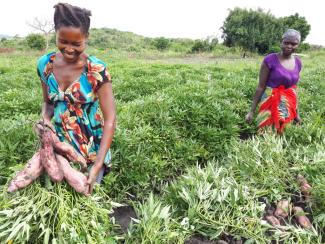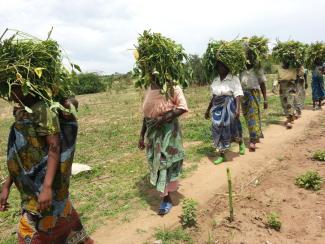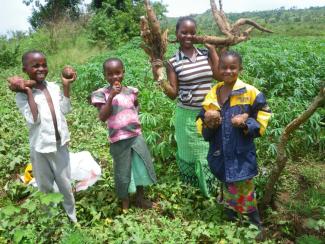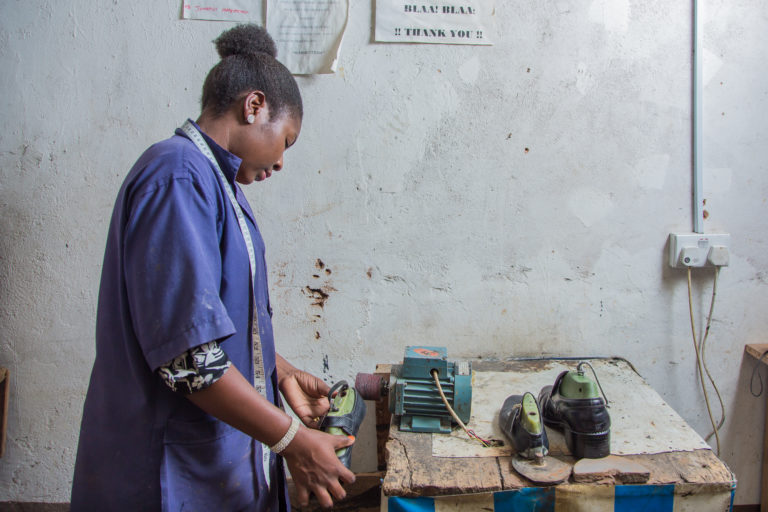“We want to ensure that where important engagement is being conducted, women are at the table."
In Rwanda and Tanzania, women drive agricultural production. It's time to hear what they have to say.
By Lauren Evans
Achieving Gender Equality in East Africa
There’s no question that women play a crucial role in Rwanda’s economy. Nearly 70 percent of the country’s female population is engaged in agriculture, a sector that accounts for a third of its GDP and nearly half of its export revenue. From planting seeds to harvesting crops, women are the driving force behind the country’s food production.
But even though women are well-represented as farmers, that doesn’t mean they have a say when it comes to the issues that affect them.
“Most of the work done in agriculture is done by women, but what is lacking is that women are not in decision-making positions,” says John Mugabo, a coordinator with the Rwanda Development Organisation (RDO). Among Rwanda’s farmer organizations, few leadership positions have historically been held by women; even on a household level, the money from the produce women grow usually winds up in the hands of men.

The problem of undervaluing women and girls is one that persists across the globe, but the hardships borne by women are most severe in the world’s poorest communities. Every day, around 830 women die from preventable causes related to pregnancy and childbirth, with 99 percent of maternal deaths located in the Global South.
Inequality begins at an early age. Around 1 in 5 women and girls in the world were married as children—1 in 3 of whom were married before the age of 15. More than 130 million girls are not in school, including 98 million who never attended secondary school at all. This bears significant long-term consequences: For each year girls enroll in school, their yearly income increases; their future children will be healthier; and they are less likely to be married as children themselves.
99%
Of maternal deaths occur in the Global South
1 in 5
Women and girls globally are married as children
98 million
Girls never attend secondary school
If denying women and girls their personhood isn’t reason enough to fight for gender parity, there are also the monetary consequences: If women participated in the economy equally with men, the global GDP would increase by 26%—or $28 trillion—by 2025. Sub-Saharan Africa alone loses $95 billion per year due to gender inequality.
In the struggle for an equitable world, it’s clear that investing in women and girls is essential. But treating the symptoms alone is not enough. Only by addressing the root causes of inequality will systemic change be achieved.

As part of its partnership with the International Fund for Agricultural Development (IFAD), InterAction is working with organizations—RDO in Rwanda, and the Agricultural Non State Actors Forum in Tanzania (ANSAF)—to do just that.
Women farmers in Tanzania and Rwanda face similar challenges: In both countries, they make up a large percentage of the agricultural workforce; in neither country are they afforded the same rights as men.
In Tanzania, ANSAF convenes a program called JUWAVITA, which helps smallholder producers like farmers, beekeepers, and fisherfolk unite over their common interests. A key part of JUWAVITA, says ANSAF Head of Operations Honest Mseri, is making sure that women producers’ voices are elevated alongside men’s.
“We want to ensure that where important engagement is being conducted, women are at the table,” he says.
But getting women to the decision-making table requires more than simply offering them a chair. Women face numerous barriers to holding such positions, ranging from cultural disapproval to days that are already packed to the brim with existing household chores, childcare, and farming duties.
To tackle these barriers at their roots, RDO holds trainings that include both men and women. For those convinced that only men are qualified for leadership roles within farmer organizations, part of that training involves identifying organizations led by women and pointing to their successes, says Mugabo.
“We have eight farmer organizations that are led by women, and they are doing it better,” he says. “They are even more committed to what they are doing.” Trainings are also held for households, in which men and women are brought together to discuss how labor is divided and how it might be made more equitable.

Part of the difficulty of achieving gender parity—in the agricultural sector and beyond it—is that there is no cure-all solution, and what works for one community may not work for another.
In Tanzania, Mseri explains that cultural norms vary by region. “In Zanzibar, you won’t get a lot of women even attending meetings, and even when they do attend, they won’t speak when men are there,” he says. “But in some tribes, women are more vocal.” Only by understanding these differences can solutions be found—in Zanzibar, that has meant allowing women to form small groups so they can share ideas amongst themselves.
Without the input of women, neither Rwanda’s nor Tanzania’s agricultural sectors can reach their full potential. But women’s participation will not happen on its own. The transformation will require intentional work at every level, from removing structural barriers that prevent women from taking out loans, to changing ideas about gender norms and what women’s roles should or should not be.
Achieving gender equality is not an easy task, and the road to get there is not a straight one. Ensuring that women’s voices are heard is a powerful first step, one that will pave the way for true systemic change.
